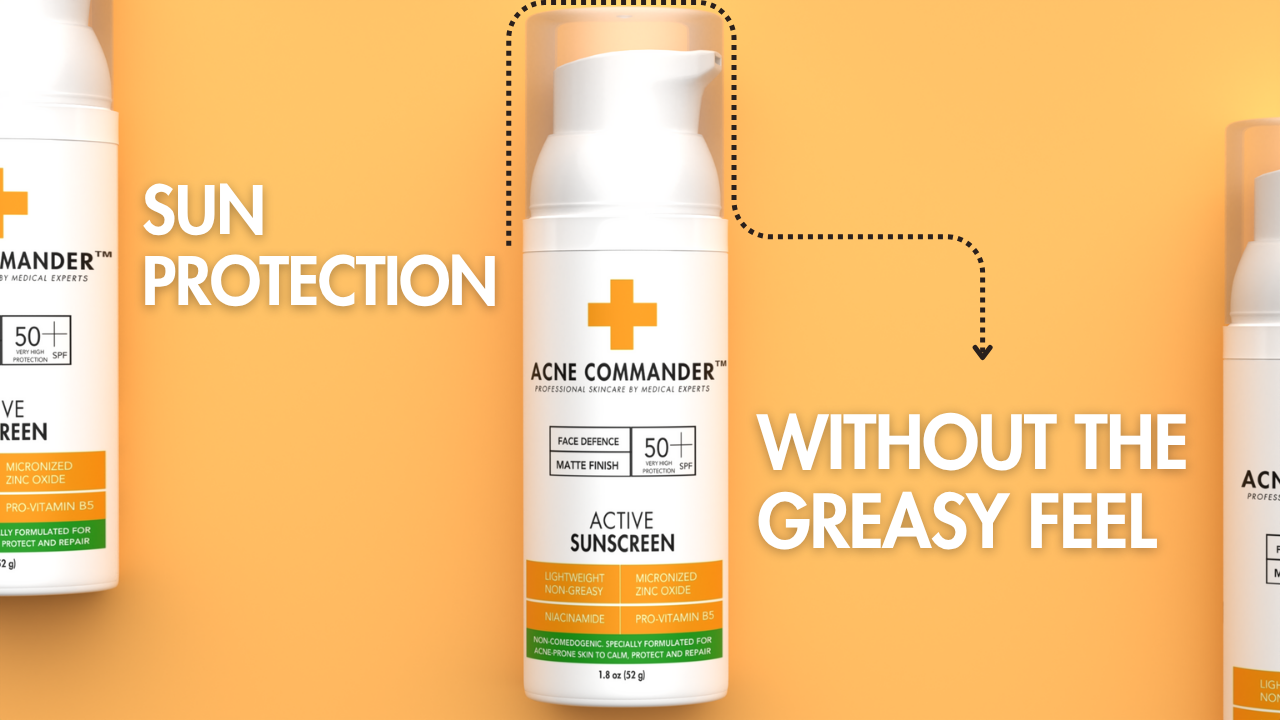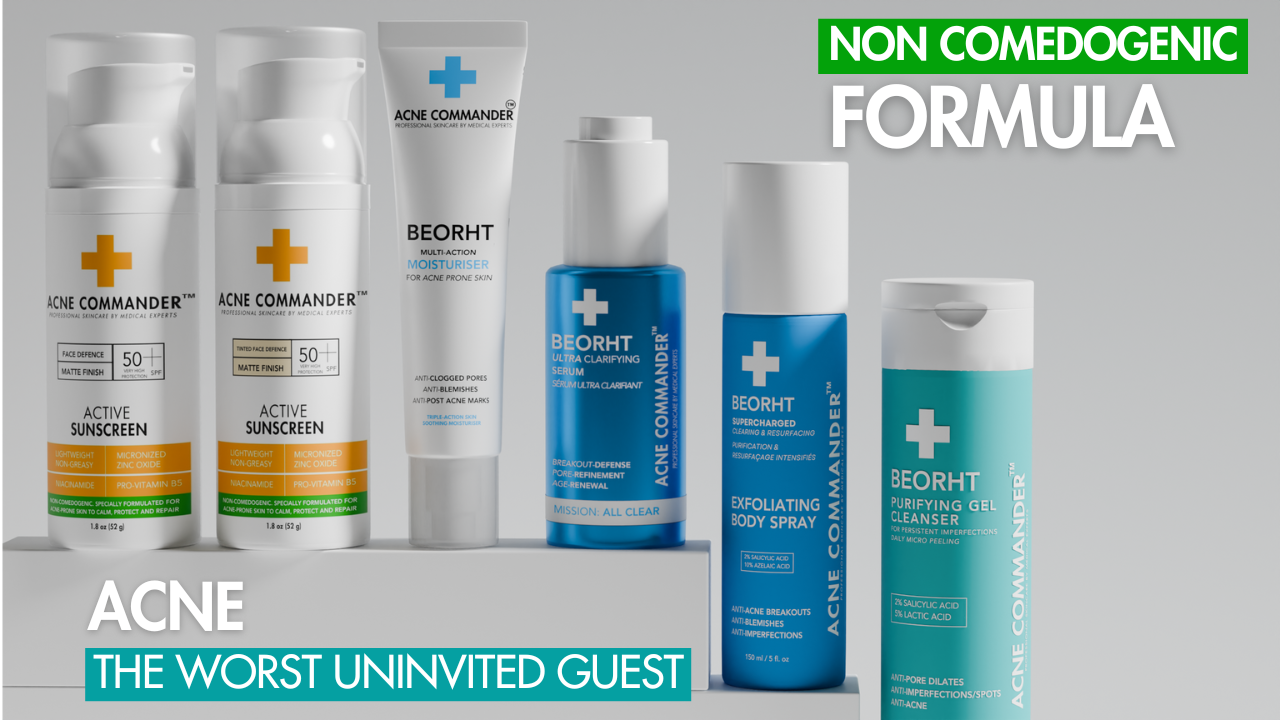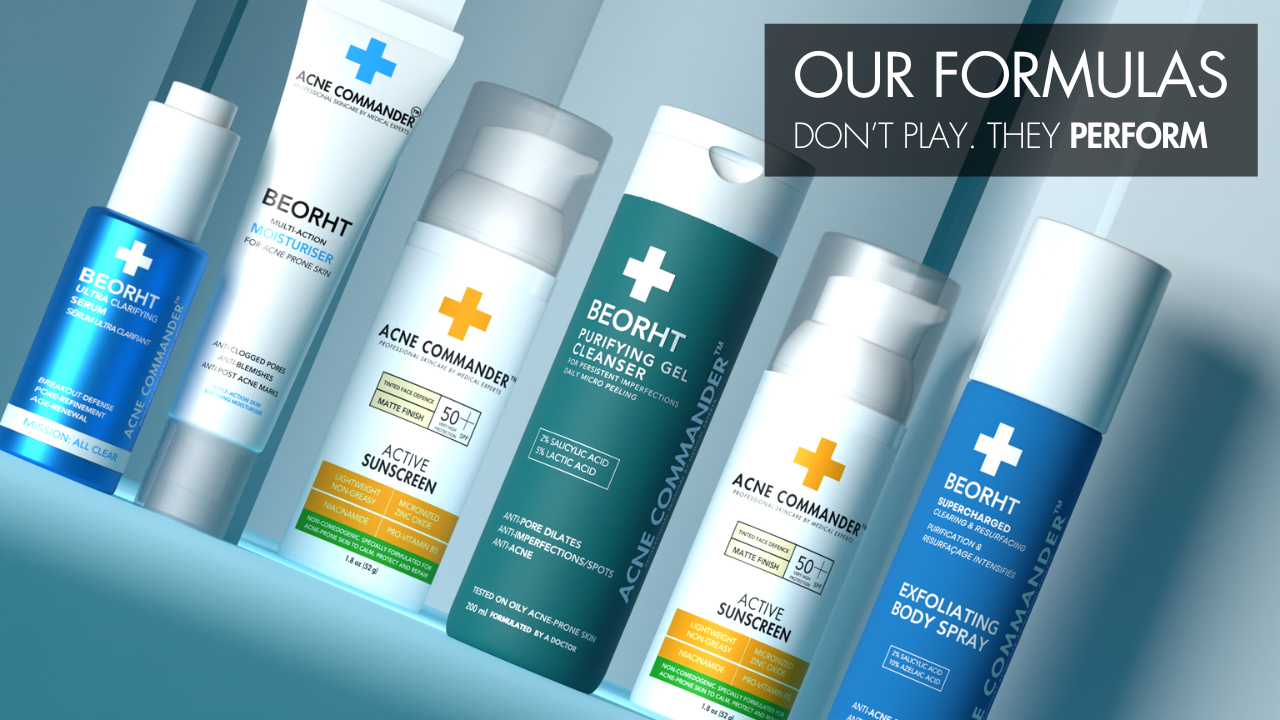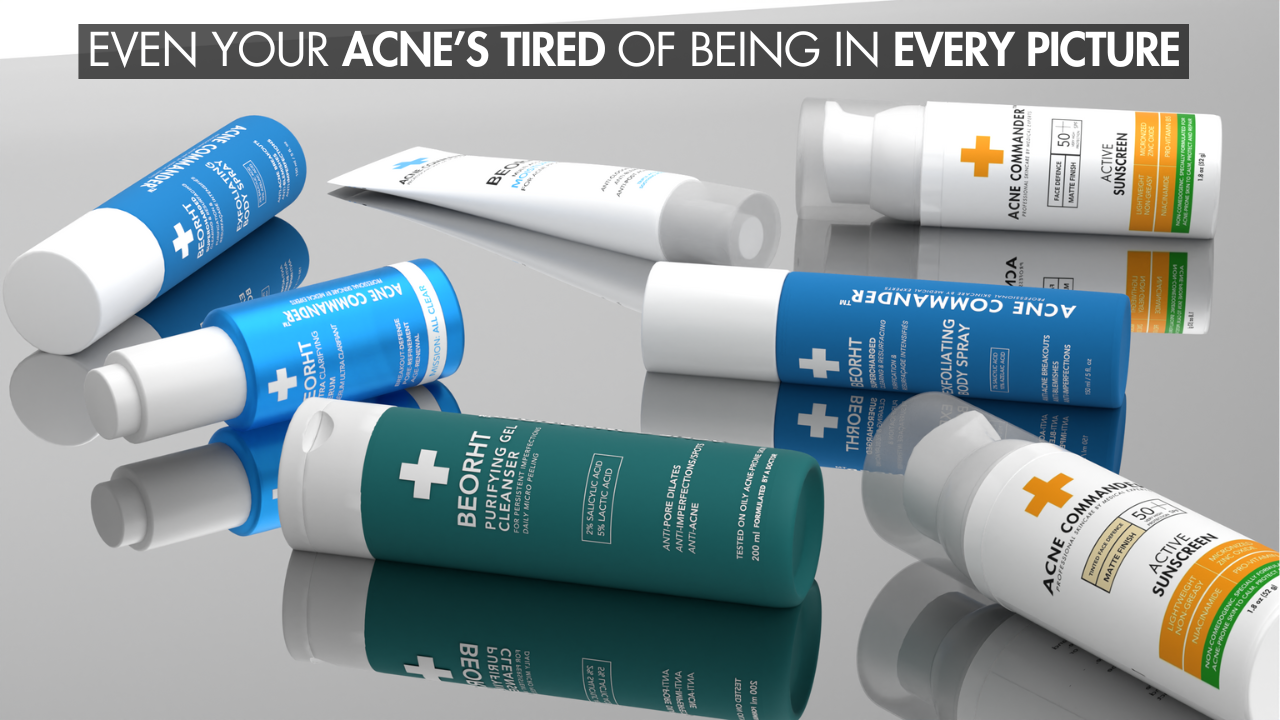Introduction
Cleansing is one of the most critical steps in any skincare routine especially for acne-prone individuals. While the right cleanser can help clear breakouts and support skin health, the wrong one can actually do the opposite. Many people are surprised to learn that their face wash might be a contributing factor to persistent acne.
Can a cleanser cause acne? The short answer is yes. Certain cleansers, especially those that are harsh, overly drying, comedogenic, or not suited for your skin type can irritate your skin, damage your skin barrier, and lead to breakouts. In this article, we’ll explore how improper cleansing can cause acne, which ingredients to avoid, and how to find the best cleanser for acne-prone skin. You’ll also learn why dermatologists and skincare experts recommend Beorht Purifying Gel Cleanser by Acne Commander as a go-to solution for those struggling with acne.
How Can a Cleanser Cause Acne?
A cleanser is meant to remove dirt, oil, and impurities from the skin, but when the wrong type of product is used, it can trigger a series of issues that lead to acne. Here's how:
Over-Drying the Skin
Using a cleanser that strips the skin of all natural oils may leave your skin feeling squeaky clean but that tight, dry feeling is not healthy. When the skin becomes dehydrated, it signals the sebaceous glands to produce more oil to compensate. This overproduction of oil can mix with dead skin cells, bacteria, and other debris, clogging pores and resulting in acne.
Disrupting the Skin’s Barrier
The skin's outermost layer also known as the acid mantle is essential for protecting against pathogens, pollution, and irritants. Harsh cleansers with sulfates, alcohols, or high pH levels can damage this barrier, leaving the skin vulnerable to infection and inflammation. An impaired barrier can lead to irritation, increased sensitivity, and more frequent breakouts.
Clogging Pores with Comedogenic Ingredients
Cleansers that contain pore-clogging (comedogenic) ingredients can trap dirt and oil inside the pores, causing whiteheads, blackheads, and cystic acne. Ingredients like coconut oil, certain silicones, and heavy waxes may be unsuitable for acne-prone skin. A truly acne-friendly cleanser, such as Beorht Purifying Gel Cleanser by Acne Commander, is formulated to be non-comedogenic and deeply purifying without over-drying.
Causing Irritation or Allergic Reactions
Cleansers with synthetic fragrances, essential oils, dyes, or alcohol can lead to inflammation or allergic responses. Irritated skin is more prone to redness, itching, and swelling all of which can worsen existing acne and trigger new breakouts.
Using a Cleanser Not Suited to Your Skin Type
Different skin types require different formulations. Using a cleanser meant for oily skin on sensitive or dry skin can cause dryness and flaking, while using a rich, creamy cleanser on oily skin may leave unwanted residue. The balanced formulation of Beorht Purifying Gel Cleanser by Acne Commander makes it suitable for various skin types, including oily, sensitive, and combination skin.
Explore detailed information for Acne Commander's Beorht Purifying Gel Cleanser. Click Here
How to Choose the Right Cleanser for Acne-Prone Skin
Choosing a cleanser that complements your skin and doesn’t contribute to breakouts is essential. Below are key features to look for:
1. Non-Comedogenic Formula
The cleanser should explicitly state that it is "non-comedogenic," meaning it won't clog your pores. Beorht Purifying Gel Cleanser by Acne Commander is formulated with ingredients that help clean deep into the pores while maintaining skin clarity.
2. Avoid Harsh Ingredients
Steer clear of alcohols, synthetic fragrances, sulfates, and parabens. These can strip the skin and cause irritation. Instead, look for gentle, soothing ingredients that calm inflammation while cleansing effectively.
3. Look for Acne-Fighting Actives
Ingredients like Salicylic Acid and Lactic Acid, both found in Beorht Purifying Gel Cleanser by Acne Commander, help to exfoliate the skin, unclog pores, and combat acne-causing bacteria.
4. Include Soothing and Hydrating Elements
Cleansers with Niacinamide, Aloe Vera, or Chamomile help reduce redness and inflammation. They also support the skin’s barrier function and hydration.
5. Maintain Hydration Balance
A good cleanser should clean the skin without stripping it. Look for hydrators like Hyaluronic Acid, Glycerin, or Sodium PCA that retain moisture during cleansing.
Ingredients in Cleansers That Can Trigger Acne
Understanding which ingredients to avoid is just as important as knowing what to look for. Some of the most common acne-triggering ingredients in cleansers include:
1. Alcohol
Drying alcohols (like isopropyl alcohol or SD alcohol) may create an illusion of cleanliness but strip away essential oils. This disrupts your skin barrier and increases oil production, contributing to breakouts.
2. Fragrances
Synthetic fragrances can irritate the skin and cause inflammation. This is especially problematic for those with acne-prone or sensitive skin. A fragrance-free formula like Beorht Purifying Gel Cleanser by Acne Commander is ideal for reducing risk.
3. Sulfates
Sodium Lauryl Sulfate (SLS) and other sulfates are foaming agents that can over-strip the skin. Repeated use leads to sensitivity, dryness, and an impaired barrier, an acne-triggering combination.
4. Comedogenic Oils and Waxes
Coconut oil, cocoa butter, and certain lanolin derivatives can clog pores and aggravate acne. Instead, look for light, non-comedogenic oils like jojoba or grapeseed oil.
How to Properly Use a Cleanser for Acne
Even the best cleanser can lead to problems if used incorrectly. Here’s how to make sure your routine supports rather than harms your skin.
Step 1: Wet the Skin with Lukewarm Water
Hot water can damage the skin barrier, while cold water won't effectively open the pores. Lukewarm water is ideal to prep your skin.
Step 2: Apply a Pea-Sized Amount of Cleanser
Massage it into the skin for 30 to 60 seconds, using gentle circular motions. Focus on oil-prone zones such as the T-zone (forehead, nose, and chin).
Step 3: Rinse Thoroughly
Leftover product residue can clog pores or irritate sensitive areas. Rinse completely and ensure no trace of the cleanser remains.
Step 4: Follow With Toner and Moisturizer
After cleansing, follow with an alcohol-free toner and a lightweight, non-comedogenic moisturizer. If you're using Beorht Purifying Gel Cleanser by Acne Commander, you’ll find it balances and preps the skin well for serums and treatments.
Why Choose Beorht Purifying Gel Cleanser by Acne Commander?
With so many cleansers on the market, why choose this one? Beorht Purifying Gel Cleanser by Acne Commander is designed for acne-prone skin and goes beyond basic cleansing. It is:
-
Formulated with Salicylic Acid and Lactic Acid to target clogged pores and refine texture
-
Non-comedogenic, making it ideal for acne-prone and oily skin types
-
Fragrance-free and sulfate-free, reducing irritation and preserving the skin barrier
-
Hydrating, with botanical extracts that calm inflamed skin
-
Dermatologist-tested and backed by science for real results
Whether you're just starting your acne treatment or looking to upgrade your routine, Beorht Purifying Gel Cleanser by Acne Commander offers gentle yet effective cleansing that won't compromise skin health.
FAQ
Q1: Can a cleanser really cause acne?
Yes. Harsh ingredients, pore-clogging compounds, or an unsuitable formula can irritate your skin or clog pores, leading to acne.
Q2: Is Beorht Purifying Gel Cleanser by Acne Commander good for sensitive skin?
Yes. It’s free from alcohol, synthetic fragrances, and sulfates, making it gentle enough for sensitive, reactive skin while still fighting breakouts.
Q3: Can a cleanser alone treat acne?
A cleanser is an important first step, but combining it with targeted treatments (like serums or spot treatments) enhances your results. Still, using a reliable cleanser like Beorht Purifying Gel Cleanser by Acne Commander lays a strong foundation.
Q4: Should I use an exfoliating cleanser every day?
If your cleanser contains exfoliants like Salicylic Acid or Lactic Acid, it’s best to start with once daily (preferably at night) and monitor your skin’s tolerance.
Q5: What if my acne worsens after switching cleansers?
You may be experiencing purging, especially if using active ingredients like BHAs. However, if irritation or breakouts persist after a few weeks, discontinue use and try a gentler option.
Final Thoughts
While cleansing might seem like a simple step, it can have a profound impact on your skin. Using the wrong cleanser can trigger breakouts, clog pores, and damage your skin barrier. That’s why it’s essential to choose a gentle, non-comedogenic formula specifically designed for acne-prone skin.
Beorht Purifying Gel Cleanser by Acne Commander stands out as a highly effective yet soothing solution. Its active ingredients target breakouts while calming inflammation and preserving moisture. It’s a smart choice for anyone serious about achieving clear, balanced, and healthy skin.
Call to Action:
Ready to take control of your acne? Try Beorht Purifying Gel Cleanser by Acne Commander today and experience the difference of science-backed, skin-loving care.






